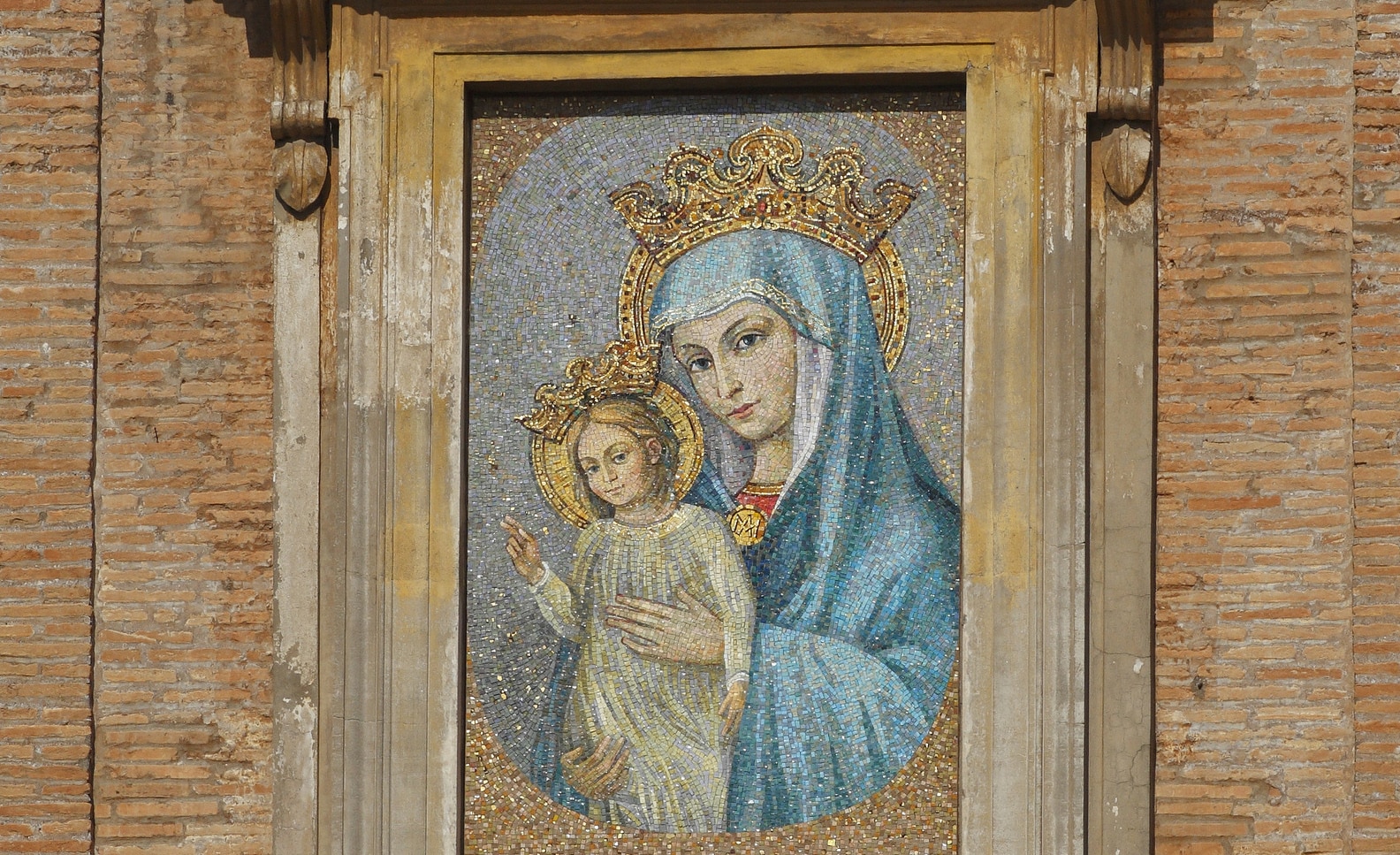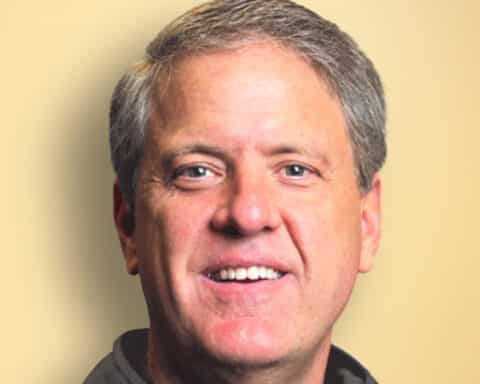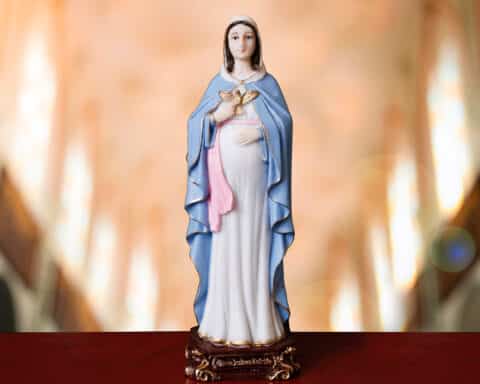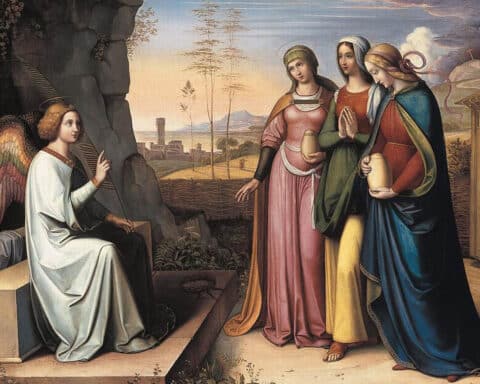On May 1, in the wake of the COVID-19 pandemic, Archbishop José H. Gomez of Los Angeles, president of the U.S. Conference of Catholic Bishops, led the Church in the United States in a consecration to the maternal care of the Blessed Virgin Mary. A similar entrustment took place on the same day in other countries as well, including Canada and Italy. Turning to Mary’s witness, protection and intercession at this moment, especially considering what the Church faces ahead, is for our good.
“Today, we ask our Blessed Mother to turn her eyes of mercy toward us — to help her children in this time of trial, when many are dying and our faith is being tested,” Archbishop Gomez said. “We ask her to intercede with her Son, to protect us and deliver us from this evil of the coronavirus.”
With the global effects of the coronavirus still uncertain, difficult and unprecedented challenges face us in virtually every aspect of life — and current scientific analysis seems to indicate that we are unlikely to be rid of the disease anytime soon. Since it is inevitable that the Church will continue to be greatly affected by COVID-19, it is fitting and timely that the U.S. bishops have consecrated our land to Mary under the title of Mother of the Church, for Mary has much to offer us in the days ahead. Her example and witness, always of utmost importance to the faithful, are especially fitting during challenging times. As we face this pandemic, we need her maternal strength, inspiration and assistance.
Facing the threats
As of this moment, it seems almost certain that the coronavirus will deeply affect the Church’s life and mission, with ramifications in both the short and the long term. Nothing we’ve encountered in the past is entirely similar to what we now face. For instance, consider how different the Church’s institutional makeup is now compared to just a century ago when the Spanish Flu unfurled its damage. This especially is true in the United States, where the Church now employs a large number of laypeople in parishes, schools and other institutions.
Much of what we have come to recognize as a given in ecclesial life will change or go away. The financial burdens incurred from the suspension of public Masses and closures of schools undoubtedly will shrink the Church’s institutional footprint and services. Reports show that many dioceses and parishes already are cutting pay or laying off staff.
| HISTORY OF CONSECRATIONS TO MARY |
|---|
|
The United States was placed under the protection of the Blessed Virgin Mary by the nation’s first bishop, Archbishop John Carroll. In 1792, he consecrated the country to Mary under the title “Immaculate Conception.” This was renewed by the country’s bishops in 1846. In 1959, at the dedication of the Upper Church of the National Shrine of the Immaculate Conception (now a basilica) in Washington, D.C., Cardinal Patrick O’Boyle led Ameria’s bishops in a renewal of that consecration. Archbishops and bishops in various places have consecrated to Mary their archdioceses and dioceses at various times and in different circumstances. The consecration on May 1 is significant because each bishop in America was asked to personally renew our nation’s consecration to Mary on the same day. The liturgy of the consecration was livestreamed on the Facebook, Twitter and Instagram pages of the USCCB. A PDF of the liturgy’s worship aid can be found here.
|
Equally great will be the spiritual ramifications of this pandemic, and we are already watching them play out. It is inevitable that the Church will see its numbers decrease for reasons that are many and varied (some will drift after a lack of practicing the Faith; others may be afraid to gather in crowds, etc.). In addition, limited access to the sacraments is presenting a variety of pastoral issues that will demand the full attention of our pastors and robust guidance on how we proceed as people of faith at this time. The coronavirus is even threatening the Church’s already fragile unity as some Catholics are sparring with leadership (and, inevitably, each other) over how and when bishops should reinstate public Masses and advise distribution of Communion.
And so we know that the institutional Church faces some challenging times ahead.
It makes sense, then, to cast ourselves at our mother’s feet as the Church begins the hard, outside-the-box thinking that will be necessary for forward movement. As we are forced to rethink and reimagine so much about ecclesial life and ministry, we can turn to Mary, who had to rethink and reimagine her whole life after she pronounced her fiat in the presence of the archangel Gabriel. In a life filled with sorrow, Mary kept moving forward with faith, hope and charity. Her example and witness, always of utmost importance to the faithful, are especially fitting during challenging times. As we face this pandemic, we need her maternal strength, inspiration and assistance.
Facing the future with Mary
We know we need our mother — but why have our bishops chosen to appeal to her under the title Mary, Mother of the Church? In describing the significance of Mary’s title as “Mother of the Church,” Pope St. Paul VI, in his 1967 apostolic exhortation Signum Magnum, taught the Church must be “firm in [Mary’s] faith, ready in her obedience, simple in humility, exulting in praising the Lord, ardent in charity, strong and constant in the fulfillment of her mission to the point of sacrificing herself, in full communion of sentiments with her Son who immolated himself on the cross to give men a new life.” Put succinctly, we can find in Mary a path through the darkness of the present moment. As we ponder what all this means in our own hearts, we can enter into Mary’s heart and see that all has not been lost.
The diminishment of sacramental life in the Church these days has presented many challenges, but for people of faith, it also has presented opportunities, including a chance to revisit some of the neglected aspects of our faith. Albeit unintentionally, the great gift of the Eucharist often overshadows the enormity of baptism’s importance in the Christian life. As many of us have been turning to spiritual communion during this crisis, we’ve been given an opportunity to rediscover the profound gift of baptism and its effects in our lives. As our portal into the life of grace, baptism is where our relationship with the Lord truly begins; and because in baptism we become members of Christ’s body, it is also when Mary becomes our mother. As our mother, Mary is our guide in Christian life, instructing us to listen to her Son and “do whatever he tells you” (Jn 2:5). She also becomes our model for worshipping God always and everywhere, and meditating on her life and virtues provides a definitive model of eucharistic living.
As members of the Body of Christ, we can find in our mother Mary the model for Christian discipleship. Mary shows that discerning our response to God’s call involves a deep interior life and a dependence on prayer: “But she was greatly troubled … and pondered what sort of greeting this might be” (Lk 1:29). Mary teaches us about receptivity to God’s will and gives us a model of docility to the movements of the Holy Spirit: “Behold, I am the handmaid of the Lord. May it be done to me according to your word” (Lk 1:38). As “full of grace,” Mary shows us how eagerly to await God’s call with readiness and anticipation. There is no doubt that God is calling us out of complacency and the status quo in the present moment. Like Mary’s, ours must be an obedient heart truly attuned to God’s voice. Mary is preeminent among “those who hear the word of God and do it” (Lk 11:28).
As the Church charts its next steps, Mary will be our strength. In the midst of all we face, she will help train our eyes on the Lord. Consenting to God’s plan was no easy task for Mary: it meant giving birth in a stable, fleeing to a foreign land and no small amount of sorrow. Like Mary, as people of faith, we must recognize God’s providence even in the greatest difficulties. Though she stood at the foot of the cross — a sign of her total trust and confidence in God’s goodness — Mary, our mother, crowned queen of heaven and earth, assures us that the cross is not the end of the story.
On the cross, Christ entrusts humanity to his Mother: “Behold, your mother” (Jn 19:27). As we approach the nation’s reconsecration to Mary, we commend ourselves to her prayers and intercession, confident in the hope “that all things work for good for those who love God, who are called according to his purpose” (Rom 8:28). Most importantly, we must model Mary’s example and seek her intercessions to be people of love. If we let them, the difficulties and strains we face in the months and years ahead can be occasions for strife and discord. But when we model our hearts after our mother Mary, even the most painful situations can be transformed by love.
Michael R. Heinlein is editor of SimplyCatholic.com. He writes from Indiana.





